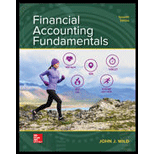
Concept explainers
Cash flow statement is that statement in which, transaction related to cash are recorded. It is mandatory report and included in the financial statement of the company. It is divided into three parts operating activities, investing activity, and financial activity
Operating Activity:
Operating activity is the first part of the cash flow statement. The main focuses of the operating activity on the
Financial Activity:
Financial activity is the part of the cash flow statement. Financial activity involves the long term liability, borrowing and
Investing Activity:
Investing activity is the third part of the cash flow statement which gives the information related to the acquisition and disposal of the long term assets of the company such as land and building, investment and plant.
To prepare: Cash flow statement
Explanation of Solution
| Cash flow statement | Amount($) | Amount($) |
| Cash flow from operating activities: | ||
| Net income | 99,510 | |
| Adjustment for non cash expense | ||
| Add: | 58,600 | |
| Less: Gain on sale of the machinery | (2,000) | |
| Adjustment for | ||
| Add: Increase in working capital | (4,700) | |
| Net cash flow from operating activities | 151,410 | |
| Cash flow from investing activities | ||
| Cash received on sale of equipment | 10,000 | |
| Cash paid for acquiring new equipment | (57,600) | |
| Cash flow from investing activities | (47,600) | |
| Cash flow from financing activities: | ||
| Cash from issuance of share | 60,000 | |
| cash paid on retirement | (30,000) | |
| Cash paid for dividend | (90,310) | |
| Cash flow from financing activities: | (60,310) | |
| Net increase in cash | 43,500 | |
| Cash and cash equivalent, December 31,2016 | 44,000 | |
| Cash and cash equivalent, December 31,2017 | 87,500 |
Table (1)
Working note:
Calculate the working capital change
| Particular | 2017 | 2016 | Increase/decrease |
| 63,800 | 51,000 | 14,000 | |
| Inventory | 63,800 | 86,500 | (22,700) |
| Prepaid expenses | 4,400 | 5,400 | (1,000) |
| Increase(Decrease) in current assets(D) | (9,700) | ||
| account payable | 25,000 | 30,000 | 5,000 |
| Wages payable | 6,000 | 15,000 | (9,000) |
| Income tax payable | 3,400 | 3,800 | (400) |
| Increase(decrease) in current liabilities(E) | (14,400) | ||
| Increase (Decrease) in working capital | 4,700 |
Table (2)
Calculate the cash received on sale of the equipment,
| particular | Amount(S) |
| 9,000 | |
| Add: Depreciation for the year | 58,600 |
| Less: Accumulated depreciation | (27,000) |
| Depreciation on equipment sold | 40,600 |
| Original cost of the equipment sold | 48,600 |
| Less: Depreciation on equipment | (40,600) |
| Book value of the equipment sold | 8,000 |
| Add: Gain on sale | 2,000 |
| Cash received on sale of equipment | 10,000 |
Table (3)
Calculate the cash dividend paid,
2.
Cash flow on total assets:
Cash flow on total assets ratio is that ratio through which company ability to meet its obligation can be seen whether company in the position to meet its obligation or not.
To determine:
2.
Explanation of Solution
Explanation:
Given,
Cash flow from operation is $151,410.
Opening balance of the assets is $317,700.
Closing assets of the assets is $292,900.
Formula to calculate the cash flow on total assets,
Substitute, $151,410 for the cash flow from operations and $305,300.
Working note:
Calculate average total assets,
Hence, cash flow on assets ratio is 49.59%.
Want to see more full solutions like this?
Chapter 12 Solutions
FINANCIAL ACCT.FUND.(LOOSELEAF)
- I need help with this general accounting problem using proper accounting guidelines.arrow_forwardPlease explain the solution to this general accounting problem with accurate explanations.arrow_forwardPlease provide the accurate answer to this general accounting problem using valid techniques.arrow_forward
- Can you solve this general accounting problem with appropriate steps and explanations?arrow_forwardPlease explain the solution to this general accounting problem using the correct accounting principles.arrow_forwardI need guidance with this general accounting problem using the right accounting principles.arrow_forward
 Financial Accounting: The Impact on Decision Make...AccountingISBN:9781305654174Author:Gary A. Porter, Curtis L. NortonPublisher:Cengage Learning
Financial Accounting: The Impact on Decision Make...AccountingISBN:9781305654174Author:Gary A. Porter, Curtis L. NortonPublisher:Cengage Learning Intermediate Accounting: Reporting And AnalysisAccountingISBN:9781337788281Author:James M. Wahlen, Jefferson P. Jones, Donald PagachPublisher:Cengage Learning
Intermediate Accounting: Reporting And AnalysisAccountingISBN:9781337788281Author:James M. Wahlen, Jefferson P. Jones, Donald PagachPublisher:Cengage Learning Cornerstones of Financial AccountingAccountingISBN:9781337690881Author:Jay Rich, Jeff JonesPublisher:Cengage Learning
Cornerstones of Financial AccountingAccountingISBN:9781337690881Author:Jay Rich, Jeff JonesPublisher:Cengage Learning College Accounting (Book Only): A Career ApproachAccountingISBN:9781337280570Author:Scott, Cathy J.Publisher:South-Western College PubPrinciples of Accounting Volume 1AccountingISBN:9781947172685Author:OpenStaxPublisher:OpenStax College
College Accounting (Book Only): A Career ApproachAccountingISBN:9781337280570Author:Scott, Cathy J.Publisher:South-Western College PubPrinciples of Accounting Volume 1AccountingISBN:9781947172685Author:OpenStaxPublisher:OpenStax College Managerial AccountingAccountingISBN:9781337912020Author:Carl Warren, Ph.d. Cma William B. TaylerPublisher:South-Western College Pub
Managerial AccountingAccountingISBN:9781337912020Author:Carl Warren, Ph.d. Cma William B. TaylerPublisher:South-Western College Pub





